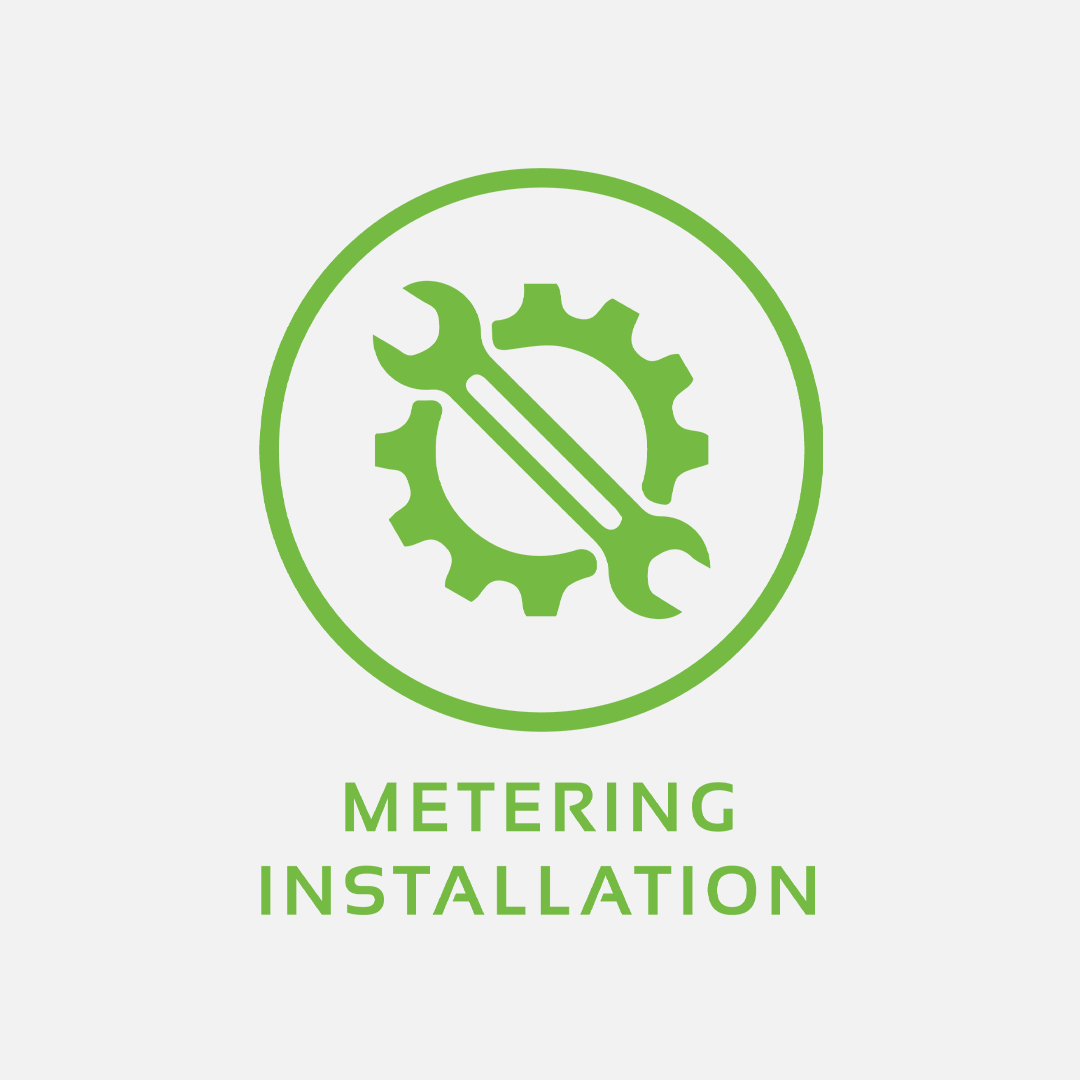METERING & VALIDATION
Gain visibility of your energy saving potential with our metering installation & validation service.
Visibility of your energy USE is critical to your carbon reduction strategy
Our Metering Installation & Validation service offers a comprehensive solution for accurate and reliable sub-metering. We manage turnkey metering installations and conduct thorough validation of existing metering deployments. The output of this enables businesses to make informed decisions, baseline and measure energy projects while identifying high consuming areas of the business quickly. Meters can then be used for accurate tenant recharging in multi-tenanted buildings or for measurement and verification of consumption in different areas or assets within a building. Our service enhances transparency, compliance, and cost-efficiency in energy management strategies, fostering positive operator-landlord-tenant relationships and maximising returns on investment for any asset owner or operator.
Our METERING CAPABILITIES
-
Button
Our in-house metering team supply and install best of breed energy metering technology from manufacturers such as Carlo Gavazzi and Schneider.
-
Button
Save you the cost of replacement meters, by extracting data from your existing networks and systems to aid
tenant recharging and sub metering strategies.
-
Button
Market leading BEMS (Building Energy Management System) expertise, who can install, maintain and drive savings via remote optimisation.
-
Button
We can help review existing meter accuracy, identifying issues with hardware, installation quality and commissioning, to generate customer savings.
-
Button
We can develop metering strategies depending on your objectives, whether it be the basis for energy savings initiatives or tenant recharging.
WHAT DO OUR CLIENTS SAY?

“The comprehensive combination of skillsets at Optimised, covering control and energy efficiency, has helped us deliver results that have far exceeded expectations and delivered significant energy and cost savings”

“Optimised have been instrumental in transforming the way we operate to significantly reduce our energy expenditure”

“The knowledge and expertise shown by the Optimised team has been critical throughout this project”
GOT A QUESTION ABOUT METERING?
FREQUENTLY ASKED QUESTIONS
-
What is a Fiscal Meter?
A fiscal meter, also known as a fiscal flow meter or custody transfer meter, is a specialised type of meter used to measure the flow rate and quantity of fluids (such as liquids or gases) during transactions where accurate measurement and billing are critical. These transactions often involve the transfer of commodities, such as oil, gas, water, or other fluids, between different parties, and the measurements obtained from fiscal meters are legally binding for financial and regulatory purposes.
Key characteristics of fiscal meters include:
Accuracy: Fiscal meters are designed to provide highly accurate measurements, often with precision standards specified by relevant regulatory authorities.
Reliability: These meters must be dependable and resistant to factors that might affect accuracy, such as temperature changes, pressure variations, and fluctuations in fluid properties.
Traceability: The calibration and testing of fiscal meters are typically traceable to recognised standards to ensure consistent accuracy across different measurement devices.
Tamper Resistance: Fiscal meters are often equipped with security features to prevent tampering and unauthorised access, ensuring the integrity of the measurement data.
Data Recording: Many modern fiscal meters are equipped with data logging and communication capabilities to record measurement data and transmit it to central systems for billing and monitoring.
Compliance: Fiscal meters must meet industry standards and regulations, as they play a crucial role in financial transactions and regulatory compliance.
Fiscal meters are commonly used in industries such as oil and gas, water distribution, and utilities where the accurate measurement of fluid flow is critical for billing and contractual purposes. They help ensure fair and accurate financial transactions between buyers and sellers, and they play an essential role in maintaining the transparency and accountability of fluid transfers.
-
What are Sub Meters?
Sub-meters, also known as submetering systems, are individual meters that measure the consumption of utilities (such as electricity, water, gas, or heat) for specific sections or components within a larger building or property. Unlike the main utility meter, which measures the total consumption of the entire building, sub-meters provide separate measurements for specific areas, units, or equipment. Sub-metering allows for more detailed tracking of utility usage and provides various benefits, especially in multi-tenant buildings or facilities with multiple consumption points.
Key features and benefits of sub-meters include:
Detailed Consumption Analysis: Sub-meters provide granular data on utility consumption for specific areas or units, allowing building owners, managers, or tenants to understand and analyse usage patterns.
Cost Allocation: Sub-metering enables fair and accurate allocation of utility costs among different tenants, departments, or units based on their actual consumption.
Incentivising Conservation: When tenants or occupants are aware of their individual utility consumption, they are more likely to adopt energy-saving practices and reduce wasteful usage.
Billing Accuracy: Sub-metering ensures precise billing based on actual consumption rather than relying on estimates or fixed apportionments.
Identifying Anomalies and Issues: Abnormal or excessive consumption detected by sub-meters can indicate potential leaks, inefficiencies, or equipment malfunctions that need attention.
Data-Driven Decisions: Sub-metering data can inform decisions about energy efficiency upgrades, maintenance schedules, and infrastructure investments.
Regulatory Compliance: In some jurisdictions, sub-metering might be required by building codes or regulations for certain types of properties.
Tenant Engagement: Sub-metering can promote tenant engagement in sustainability efforts and energy conservation initiatives.
Sub-meters can be installed at various levels within a building, such as individual apartments, offices, retail spaces, floors, or specific equipment like HVAC systems or lighting circuits. The collected data from sub-meters can be integrated into a Building Energy Management System (BEMS) or central monitoring system for real-time analysis and reporting.
Overall, sub-meters contribute to improved resource management, cost control, and sustainability by providing more accurate insights into utility consumption patterns and enabling informed decision-making.
-
What are Smart Meters?
Smart meters are advanced digital devices used to measure and record the consumption of utilities such as electricity, gas, and water. Unlike traditional meters, which require manual readings and often provide limited information, smart meters offer real-time monitoring, two-way communication, and various data-related features. They are a key component of modern utility management and can play a significant role in promoting energy efficiency, reducing costs, and enhancing customer experience.
Key features and benefits of smart meters include:
Real-Time Monitoring: Smart meters provide up-to-date information on utility consumption, allowing consumers and utility providers to monitor usage patterns and make informed decisions.
Automated Reading: Smart meters eliminate the need for manual meter reading. Data is collected remotely and transmitted directly to the utility company, reducing errors and operational costs.
Accurate Billing: With accurate, real-time data, smart meters enable precise billing based on actual consumption, reducing estimated bills and billing disputes.
Energy Efficiency: Consumers can track their usage patterns and make informed choices to reduce consumption and lower energy bills.
Peak Load Management: Utilities can manage peak demand more effectively by encouraging consumers to shift usage away from high-demand periods through pricing incentives.
Remote Control: In some cases, smart meters allow utilities or consumers to remotely control certain appliances or devices, contributing to demand response programmes and energy conservation.
Time-of-Use Pricing: Smart meters support flexible pricing structures, where the cost of energy varies based on the time of day. This encourages consumers to use energy during off-peak hours.
Data Analytics: The data collected by smart meters can be analysed to identify trends, anomalies, and opportunities for efficiency improvements.
Improved Grid Management: For utilities, smart meters contribute to better grid management, outage detection, and more accurate load forecasting.
Renewable Energy Integration: Smart meters facilitate the integration of renewable energy sources by providing insights into generation and consumption patterns.
Consumer Awareness: By offering real-time data, smart meters increase consumer awareness of energy consumption and encourage sustainable practices.
Smart meters are a foundational technology in the development of smart grids, which are modern electricity distribution networks that leverage digital communication and information technology to enhance efficiency, reliability, and sustainability.
Overall, smart meters empower consumers and utilities with real-time data, improve billing accuracy, support energy efficiency initiatives, and contribute to the modernisation of utility systems.
-
What is a Virtual Meter?
A virtual meter is a concept used in energy management and measurement that refers to a calculated or simulated energy metering value rather than a physical device. It is a computational tool used to estimate, aggregate, or represent energy consumption or generation for specific areas, systems, or equipment within a building or facility. Virtual meters are often employed in situations where installing physical meters might be impractical or cost-prohibitive.
Key points about virtual meters include:
Calculation-based: Virtual meters derive their measurements from data analysis and mathematical calculations rather than direct physical measurements from a metering device.
Aggregation: Virtual meters can consolidate data from multiple sub-meters or sources to provide a comprehensive view of energy consumption for a specific area or process.
Estimation: In some cases, virtual meters estimate energy usage based on known factors, historical data, or algorithms.
Specialised Metrics: Virtual meters can be used to measure specific parameters, such as energy intensity (energy consumed per unit of production), demand response, or energy performance indices.
Non-Intrusive: Since they don't require the installation of physical devices, virtual meters are non-intrusive and can be more easily integrated into existing systems.
Flexibility: Virtual meters can be adapted and reconfigured without the need for physical changes, allowing for dynamic monitoring and analysis.
Applications: Virtual meters are useful in various contexts, including sub-metering complex systems, assessing energy performance, tracking energy savings from efficiency projects, and providing insights into renewable energy generation.
Integration: Virtual meters often interface with energy management software or building management systems to provide real-time data and analysis.
While virtual meters offer flexibility and cost savings, their accuracy and reliability depend on the quality of input data and the algorithms used for calculations. They can provide valuable insights and help make informed decisions about energy consumption, but it's important to ensure that the underlying data and calculations are robust and accurate.
-
What is AMR (Automatic Meter Reading)?
AMR, which stands for Automatic Meter Reading, is a technology used for remotely collecting consumption data from utility meters, such as electricity, gas, water, or heat meters.
Key features and benefits of AMR include:
Remote Data Collection: AMR allows utility companies to collect metering data automatically without the need for manual readings. This enhances efficiency and accuracy in billing and data management.
Real-Time Monitoring: AMR systems provide near-real-time data on consumption patterns, enabling both utility providers and consumers to monitor usage trends.
Reduced Costs: AMR eliminates the need for physical meter reading visits, reducing associated labour costs and the potential for human errors.
Billing Accuracy: With accurate and up-to-date consumption data, AMR helps ensure precise billing based on actual usage.
Time Savings: Both consumers and utility companies save time since there's no need to schedule meter reading appointments.
Early Problem Detection: AMR can help identify anomalies or irregular consumption patterns, aiding in the early detection of leaks, inefficiencies, or equipment malfunctions.
Data Analytics: The data collected through AMR systems can be analysed to gain insights into energy usage, trends, and efficiency opportunities.
Demand Response: AMR can support demand response initiatives by providing timely information to adjust energy consumption during peak demand periods.
Flexible Communication: AMR systems use various communication technologies, such as radio frequency, cellular networks, or powerline communication, to transmit data from meters to central systems.
AMR technology has evolved to include advanced functionalities, such as integration with smart meters and support for different utility types. It plays a crucial role in modernising utility management and enhancing customer service by providing more accurate, timely, and actionable data.
Start your decarbonisation journey with actionable insights into your energy wastage
Additionally, the data collected enables us to identify energy decay, waste and uncover valuable cost-saving opportunities, allowing you to implement targeted efficiency measures and further improve your bottom line.
Partner with us to ensure fair and precise utility cost allocation for property owners and tenants, while creating the visibility into where and when energy is being consumed.
OUR OFFICES
ASHBY DE LA ZOUCH
1 Ivanhoe Office Park
Ivanhoe Park Way
Ashby de la Zouch
Leicestershire, LE65 2AB
BLACKPOOL
109-112
Lancaster House
Amy Johnson Way
Blackpool, FY4 2RP
BRISTOL
Hanover House
Queen Charlotte Street, Bristol, BS1 4EX
SITTINGBOURNE
The Oast
62 Bell Road
Sittingbourne
Kent, ME10 4HE
About Optimised
Popular Pages
Subscribe
Join the Newsletter - Footer (D)
We will get back to you as soon as possible
Please try again later
Join the Newsletter - Footer (M)
We will get back to you as soon as possible
Please try again later














